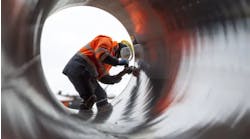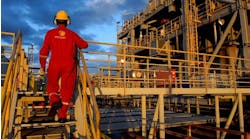View Article as Single page
Sensitivity of results to CO2 costs. The volumes of economically viable incremental oil recovery and CO2 demand from the GoM OCS, using current CO2-EOR technology, are highly sensitive to the availability and cost of CO2 delivered to offshore oil fields.
The study notes that a key priority is to continue the research and development for lowering the cost of CO2 capture because CO2 costs above $60/mt, in the best case, would make the use of current technology CO2-EOR in the GoM OCS uneconomic.
Conversely, with lower cost CO2 of $40/mt (possible with advanced CO2 capture technology and the use of empty offshore natural gas pipelines for CO2 transportation), the oil recovery and CO2 storage potentials would increase.
Sensitivity of results to oil price. Because current CO2-EOR technology provides only modest volumes of additional oil, a higher oil price is generally required for economic viability. At an oil price of $135/bbl and a $70/mt CO2 price (the CO2 price is linked to the oil price), the oil recovery and CO2 storage volumes from the GoM OCS become significant – 2,820 MMbbl of incremental oil and 1,140 MMmt of CO2 demand (storage).
"Next generation" technology
"Next generation" technology with its higher oil recovery efficiencies will be an essential feature of offshore CO2 enhanced oil recovery and storage.
Shallow-water oil fields, with their strong natural water driver, achieve relatively high (40% to 60%) recovery of original oil in-place, leaving a much smaller target for CO2-EOR. "Next generation" CO2-EOR technology, with its higher reservoir sweep and oil displacement efficiencies, is needed to economically target these reduced volumes of residual oil.
Deepwater oil fields, with their high cost wells and facilities, will also need higher oil recoveries than offered by current CO2-EOR technology to become economically viable for CO2-EOR. However, in contrast with shallow-water oil fields, the primary/secondary oil recovery efficiencies in deepwater oil fields are considerably lower, providing a larger residual oil target.
Substituting "next generation" CO2-EOR technology for current CO2-EOR technology, while keeping oil price ($90/bbl) and CO2 price ($50/mt), leads to a more than tenfold increase in oil recovery and CO2 demand (storage) for offshore oil fields in the GoM.
Economically viable incremental oil recovery from the GoM OCS becomes 14,920 MMbbl with "next generation" CO2-EOR technology compared to 810 MMbbl with current technology. Economic demand (storage) for CO2 by the offshore CO2-EOR industry is 3,910 MMmt with "next generation" CO2-EOR technology, compared to 310 MMmt with current technology.
The higher volumes of economically viable oil recovery from the GoM OCS from using "next generation" CO2-EOR technology are due to: more oil recovered per dollar of invested capital (i.e., spending more to implement "next generation" technology provides more oil recovery and higher overall financial returns); and the more favorable CO2 to oil ratio of 0.24 mt of CO2 per barrel of recovered oil, compared to 0.38 mt of CO2 per barrel of recovered oil with current CO2-EOR technology, lowers the cost per barrel.
Use of "next generation" CO2-EOR technology leads to much higher CO2 supply requirements, 3,910 MMmt over a 50-year time period (taking into consideration the time lapse for finding and developing undiscovered oil fields). This is about 80 MMmt of CO2 per year, equal to about 4 bcf/d. With annual Gulf Coast CO2 emissions from large point sources of 94 MMmt/year sufficient CO2 supplies are available but would need to be captured and then transported offshore.
As important, the analysis shows that the GoM OCS oil fields provide sufficient long-term CO2 storage capacity for all of the CO2 emissions generated from large point sources along the Gulf Coast.
Sensitivity of results to CO2 costs. Lower delivered costs of CO2 enable more of the offshore oil resource to become economic under "next generation" CO2-EOR.
Sensitivity of results to oil prices. Even though "next generation" CO2-EOR technology provides higher volumes of oil recovery, offshore CO2-EOR is still a high cost option that would benefit from higher oil prices.
With an oil price of $135/bbl (CO2 costs of $70/mt), the incremental oil recovery more than doubles to 38,060 MMbbl compared to 14,920 MMbbl under a $90/bbl oil price.
Similarly, with an oil price of $135/bbl (CO2 cost of $70/mt), the demand (storage) for CO2 more than doubles to 10,700 MMmt compared to 3,910 MMmt under a $90/bbl oil price.




